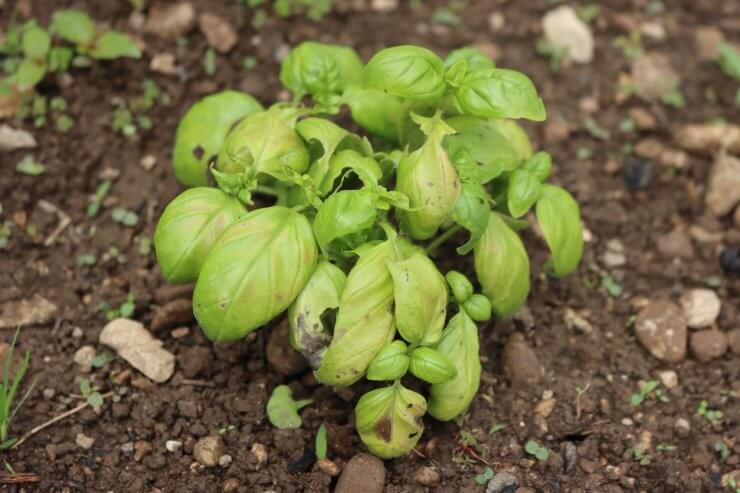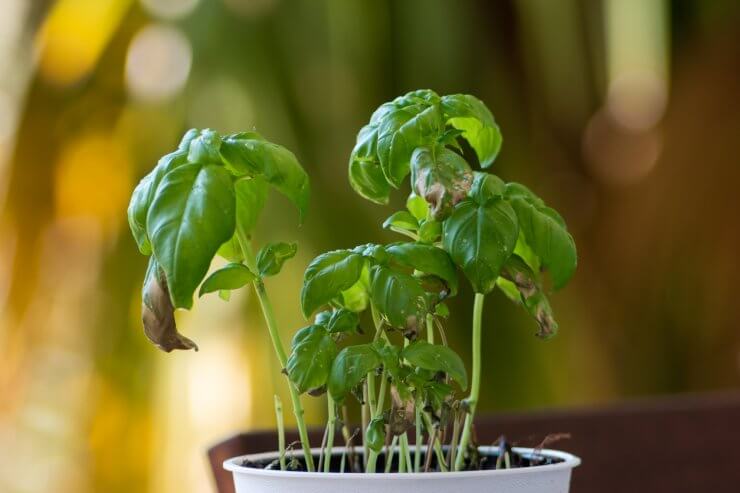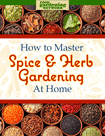
Basil is one of those wonderful herbs that makes life better. Pick a few basil leaves off the plant or chop them in your kitchen, and your nose is happy right away. Basil is also relatively easy to grow. But I’ll admit, I’ve had my share of issues with the plant, too. Rabbits have decimated my basil, some unknown pest has chewed holes in the leaves, and I’ve watched my verdant green basil leaves turning yellow.
I don’t have to tell you how disappointing this is. Sure, I love seeing those cute baby bunnies in my yard with their adorable little faces, but can’t they eat the crabgrass or the dandelions? Get off my lawn, you scoundrels!
Anyway, I’ve learned a few things over the years, and I also asked around and found some useful tips from other gardeners about basil. And now, I’m sharing it in hopes that it helps you when your basil leaves are turning yellow, critters are eating it, or other basil problems pop up.
Find out how easy growing spices and herbs can be—indoors or out! Read our FREEBIE How to Master Spice and Herb Gardening at Home right now!

What to do about basil leaves turning yellow and other common problems
Why are my basil leaves turning yellow, and what can I do about it? Unfortunately, there are a few possibilities here, and it can be challenging to pinpoint the problem. If you’re lucky, it’s just a matter of overwatering. Take a break from watering the basil, and you should see the plant perk back up.
Nitrogen deficiency is also an occasional issue. The only way to be sure is to test your soil, but the cure is to fertilize your basil plant, so it gets the nitrogen it needs.
There are also some diseases that could cause basil leaves to turn yellow.
- Downy mildew: You may see yellowing leaves or dark, discolored patches on the plant. Keeping the leaves dry and ensuring good air circulation may prevent this problem before it starts.
- Fusarium wilt: This soil-borne disease may be one cause of yellowing leaves. It’s also highly contagious and will wipe out your garden if given the chance. If you spot this issue, the best thing you can do is to pull up your basil plant and throw it in the garbage before the disease has a chance to spread.
- Root rot: Since the plant roots are below the surface, root rot can be tough to diagnose, but overwatering is, again, a primary culprit. Once the season is over, look at ways to amend the soil or adjust the landscape so there is better drainage.
Besides your basil leaves turning yellow, what other common basil problems might you see?
Aphids, whiteflies, Japanese beetles, and spider mites are all fond of basil. A neem oil spray is generally effective against these pests. Slugs enjoy basil, too. Sprinkle a little diatomaceous earth around your plants, and that should take care of the problem.
I know this seems like a lot, but the truth is, basil is a wonderful herb, it makes a great companion plant, and it really is easy to grow. If you want to go really in-depth and find out more about basil, check out the Basil Collection. Discover the origins of basil, find out about growing several common varieties, and get some delicious basil-centric recipes like homemade Basil Ice Cream!
What problems have you encountered with growing basil?
Find out how easy growing spices and herbs can be—indoors or out! Read our FREEBIE How to Master Spice and Herb Gardening at Home right now!





Across the U.S., Basil Downy Mildew is the most likely cause of serious bouts of yellowing, and is usually followed by leaf drop. A gray, fuzzy growth on the underside of the leaves is indicative of downy mildew. The best time to see the fuzzy growth is early in the morning (e.g. 8 AM) and using a hand lens is helpful. Using resistant or tolerant varieties of basil is the best way to insure a supply of fresh basil from your garden, though the pathogen responsible seems to be evolving new strains. Look for the Prospera series, as well as Cardinal (my favorite). A brand new resistant intro called Piedmont also looks very promising, and has a great aroma and classic basil flavor.
this article is very useful, thank you for making a good article
Two maintenance jobs help to keep basil fresh;
Alway trim all new blossoms; and
keep plants pruned to fight the summer bolt.
It’s hard to slow growth when your demand slacks.
I have experienced several of the problems you mentioned when growing basil. I live in Panama. Could the weather be part of the problem. Humidity and too warm temperatures?? Thanks.
Basil doesn’t like hot, hot heat, and it will cause it to bolt, so that may be the issue! Growing indoors might work better?